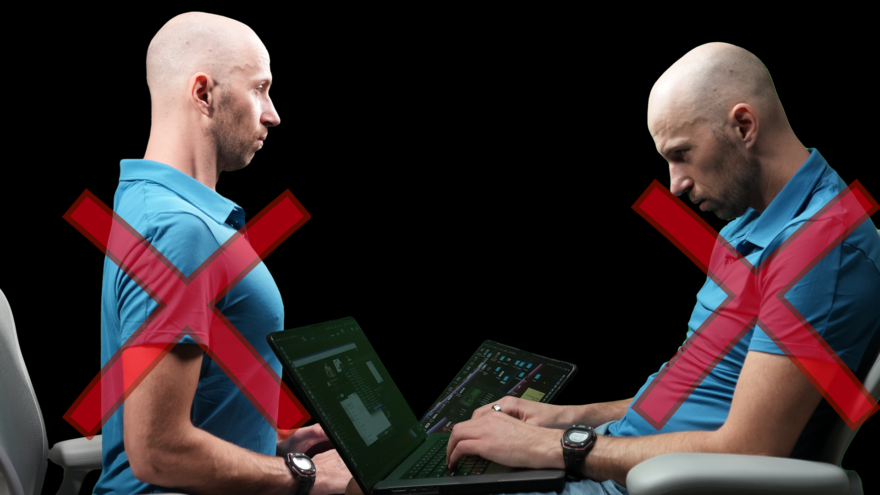Table of Contents
The TRUE Fix for Sitting
We’ve all been there – after a long day of sitting in front of a computer, you stand up and feel a twinge in your lower back. Or you’ve been sitting in perfect posture, but your neck and back are still sore.
What if I told you that perfect sitting posture isn’t the key? That you MUST focus on something different.
The real thing that’s DESTROYING your sitting.
What is that key? Read the blog post, watch the video, and listen below to learn.
Looking at Sitting Differently
Did mom ever tell you to “sit up straight?” After all, this was the solution to all your sitting woes, right?
Right?
WRONG!
Regardless of how “good” it looks, holding any posture long enough gets uncomfortable. In fact, research doesn’t show a clear relationship between sitting posture and pain.
So, what’s the REAL cause of discomfort? The issue is the amount of time we spend sitting in one position. So the actual key is making sitting less static.
The best sitting posture requires an active approach.
Here’s how we can do that.
Moving Around: The Sitting Posture Secret
What do our bodies have to do when we sit? Well, when standing, our bodies naturally sway. But when we sit, this sway goes away. How? By increasing muscular tension, which keeps us still.
The result? The stiff we are, the less motion we have, and the more discomfort experienced.
So the best “fix” for sitting posture is to get up and move often! But what if we can’t?
What to Do When You Can’t Take a Break
There are many ways to incorporate movement into sitting time when getting up isn’t an option.
Here’s how I do it:
- Change your sitting posture frequently
- Use different “desks” throughout the day (sitting, standing, treadmill, couch, etc)
- Fidget
- Mini movement breaks
Top Movement Breaks
Two of my favorite movement breaks are:
- Seated upper back expansion
- Seated overhead reach.
Here’s how to do each:
- Sit in your chair with your elbows bent and your arms held out in front of you.
- Hold a band around your wrists
- Eyes looking forward
- Silent nose inhale
- Exhale and move torso away from hands
- Spin the hands out for an added effect
- Hold for 5 sets of 5 breaths
Here’s how to do the seated overhead reach:
- Sit in your chair with 1 arm reaching overhead
- Eyes looking forward
- Silent nose inhale
- Exhale and reach toward the ceiling
- Hold for 5 sets of 5 breaths
An Often Overlooked Sitting Posture Component
Another piece that can increase tension while sitting is computer work.

When working on a screen, our eyes must focus (converge) to view the space in front of us. This focus increases muscle activity.
What if you have a hard time getting your eyes to relax after the fact?
Research (here and here) shows a link between focus-intensive work and upper body discomfort. Inability relax the focus = PROBLEMS.
There is an easy way to mitigate the negative effects of prolonged computer use. Optometrists call this the 20/20/20 rule.
The 20/20/20 rule states that every 20 minutes you should take a 20-second break to look 20 feet away. This simple habit can help reduce eye strain, neck, and back pain, and improve your posture.
It works because it reduces our focus on a single point. 20 seconds is the amount of time it takes the eyes to soften the focus, giving your upper body a chance to recharge.
Sum up
Sitting for long periods of time doesn’t have to be a recipe for discomfort. Embracing an active approach to sitting can allow you to sit comfortably for much longer. So, take a break from perfect posture and start moving!
How do you offset sitting for long periods of time? Comment below and let us know!

